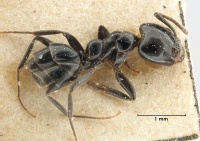Anonychomyrma nitidiceps
| Anonychomyrma nitidiceps | |
|---|---|

| |
| Scientific classification | |
| Kingdom: | Animalia |
| Phylum: | Arthropoda |
| Class: | Insecta |
| Order: | Hymenoptera |
| Family: | Formicidae |
| Subfamily: | Dolichoderinae |
| Tribe: | Leptomyrmecini |
| Genus: | Anonychomyrma |
| Species: | A. nitidiceps |
| Binomial name | |
| Anonychomyrma nitidiceps (André, 1896) | |
Anonychomyrma nitidiceps is a large-headed arboreal species with a dome-shaped mesonotum, which forages on the ground near standing trees or fallen wood. If disturbed, this species emits an odour plume that can easily be detected several metres away. Anonychomyrma nitidiceps is found in a range of woodland types in south-western Western Australia (Heterick, 2009).
Identification
Keys including this Species
Distribution
Latitudinal Distribution Pattern
Latitudinal Range: -16.06666667° to -43.15°.
| North Temperate |
North Subtropical |
Tropical | South Subtropical |
South Temperate |
- Source: AntMaps
Distribution based on Regional Taxon Lists
Australasian Region: Australia (type locality).
Distribution based on AntMaps
Distribution based on AntWeb specimens
Check data from AntWeb
Countries Occupied
| Number of countries occupied by this species based on AntWiki Regional Taxon Lists. In general, fewer countries occupied indicates a narrower range, while more countries indicates a more widespread species. |

|
Estimated Abundance
| Relative abundance based on number of AntMaps records per species (this species within the purple bar). Fewer records (to the left) indicates a less abundant/encountered species while more records (to the right) indicates more abundant/encountered species. |

|
Biology
Anonychomyrma species are common in moist to semi-arid forested areas (and are less common in rain forests). They nest either in soil with or without coverings, or arboreally in living or dead wood. Workers forage in conspicuous trails on the ground and on tree trunks. Although not studied in detail, they seem to be general predators and also collect plant juices. Some species are associated with the caterpillars of selected butterflies. Nest sizes are moderate to large, ranging from 500 to tens of thousands of workers. When disturbed, most species elevate their gasters and release strong, acrid smelling chemicals as a defensive measure. While similar to Iridomyrmex in general habitat preferences and ecology, most Anonychomyrma prefer moister sites and are predominately arboreal. Iridomyrmex species occur in drier sites and are predominantly terrestrial.
Castes
Nomenclature
The following information is derived from Barry Bolton's Online Catalogue of the Ants of the World.
- nitidiceps. Iridomyrmex nitidiceps André, 1896b: 258 (w.) AUSTRALIA (Victoria).
- Type-material: syntype workers (number not stated).
- [Note: Shattuck, 1994: 7, cites 17w syntypes (3 ANIC, 1 MCZC, 1 MHNG, 12 MNHN).]
- Type-locality: Australia: Victoria, Victorian Alps (no collector’s name).
- Type-depositories: ANIC, MCZC, MHNG, MNHN.
- Forel, 1907h: 292 (m.).
- Combination in Anonychomyrma: Shattuck, 1992a: 14.
- Subspecies of itinerans: Forel, 1902h: 472; Forel, 1907h: 292; Forel, 1911e: 283; Emery, 1913a: 25.
- Status as species: Taylor & Brown, 1985: 101; Taylor, 1987a: 32; Shattuck, 1994: 7; Bolton, 1995b: 66; Heterick, 2009: 43.
- Distribution: Australia.
Type Material
- Syntype, 3 workers, Victorian Alps, Victoria, Australia, <collector unknown>, ANIC32-014960, Australian National Insect Collection.
- Syntype, 1 worker, Victorian Alps, Victoria, Australia, Museum of Comparative Zoology.
- Syntype, 1 worker, Victorian Alps, Victoria, Australia, Musee d'Histoire Naturelle Genève.
- Syntype, 12 workers, Victorian Alps, Victoria, Australia, Musee National d'Histoire Naturelle.
Description
References
- Andersen, A. N. 2003. Records of two new ant genera, Anonychomyrma Donisthorpe and Probolomyrmex Mayr (Hymenoptera: Formicidae), for the Northern Territory. Beagle 19: 125-126 (page 125, Northern Territory)
- André, E. 1896d. Fourmis nouvelles d'Asie et d'Australie. Rev. Entomol. (Caen) 15: 251-265.(page 258, worker described)
- Beaumont, K.P., Mackay, D.A., Whalen, M.A. 2013. Multiphase myrmecochory: the roles of different ant species and effects of fire. Oecologia 172, 791–803 (doi:10.1007/s00442-012-2534-2).
- Emery, C. 1911e. Hymenoptera. Fam. Formicidae. Subfam. Ponerinae. Genera Insectorum 118: 1-125 (page 25, subspecies of itinerans)
- Forel, A. 1902j. Fourmis nouvelles d'Australie. Rev. Suisse Zool. 10: 405-548 (page 472, subspecies of itinerans)
- Forel, A. 1907j. Formicidae. In: Michaelsen, W., Hartmeyer, R. (eds.) Die Fauna Südwest-Australiens. Band I, Lieferung 7. Jena: Gustav Fischer, pp. 263-310. (page 292, male described)
- Heterick, B. E. 2009a. A guide to the ants of South-western Australia. Records of the Western Australian Museum, Supplement 76: 1-206.
- Heterick, B.E. 2021. A guide to the ants of Western Australia. Part I: Systematics. Records of the Western Australian Museum, Supplement 86, 1-245 (doi:10.18195/issn.0313-122x.86.2021.001-245).
- Heterick, B.E. 2022. A guide to the ants of Western Australia. Part II: Distribution and biology. Records of the Western Australian Museum, supplement 86: 247-510 (doi:10.18195/issn.0313-122x.86.2022.247-510).
- Shattuck, S. O. 1992a. Review of the dolichoderine ant genus Iridomyrmex Mayr with descriptions of three new genera (Hymenoptera: Formicidae). J. Aust. Entomol. Soc. 31: 13-18 (page 14, combination in Anonychomyrma)
- Shattuck, S. O. 1994. Taxonomic catalog of the ant subfamilies Aneuretinae and Dolichoderinae (Hymenoptera: Formicidae). Univ. Calif. Publ. Entomol. 112:i-xix, 1-241. (page 7, see also)
- Taylor, R. W.; Brown, D. R. 1985. Formicoidea. Zool. Cat. Aust. 2:1- 149: 1-149, 30 (page 101, revived status as species)
References based on Global Ant Biodiversity Informatics
- CSIRO Collection
- Lowery B. B., and R. J. Taylor. 1994. Occurrence of ant species in a range of sclerophyll forest communities at Old Chum Dam, north-eastern Tasmania. Australian Entomologist 21: 11-14.
- Majer J. D., R. L. Kitching, B. E. Heterick, K. Hurley, and K. E. C. Brennan. 2001. North-south patterns within arboreal ant assembalages from rain forests in Eastern Australia. Biotropica 33(4): 643-661.
- Sinclair J. E., and T. R. New. 2004. Pine plantations in south eastern Australia support highly impoverished ant assemblages (Hymenoptera: Formicidae). Journal of Insect Conservation 8: 277-286.

